Self-directed Support, Scotland, 2014-15
This ‘Data under Development’ Statistics Release presents the latest client and expenditure figures for Self-directed Support (SDS) in its first year of implementation (2014-15). SDS was introduced in Scotland on 1st April 2014 following the Social Care (
This document is part of a collection
3. Client Analysis
The analysis presented throughout Section 3 focuses on the 22 local authorities identified in Section 2.2 as having full SDS option recording. This means that aggregate-level figures are not skewed by data recording issues and will therefore more accurately reflect the Scotland-level picture. It is expected that improvements to local authority recording systems will occur in the year after roll-out of the policy and that this will improve the consistency of the information available for 2015-16.
3.1 Client Group, Assessed Needs and Support Mechanism
Figure 2 shows the breakdown of clients by client group - the main reason for the client needing a social care service. This shows that the largest groups are 'Physical Difficulty' (32%) and 'Frail Older People' (27%), which is in line with the Social Care Survey as a whole. The 'Other' group includes addictions, palliative care and carers.
Figure 2: breakdown of client group, 2014-15
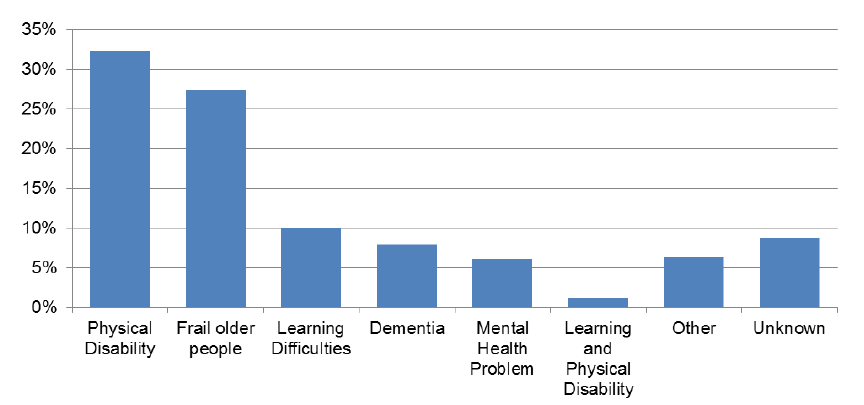
Information refers to the 22 local authorities with full SDS option recording (see Section 2.2).
Figure 3 (over page) shows the breakdown of clients by need - the type of assessed support needs that are provided for. Note that clients can be identified as having more than one support need and so the sum of percentages will exceed 100%. This shows that the largest need is 'Personal Care', identified for 47% of clients. Over a third of clients (37%), however, were classed as having 'Unknown' needs, suggesting that there are additional recording issues to those identified in Section 2.2.
Figure 3: breakdown of support needs, 2014-15
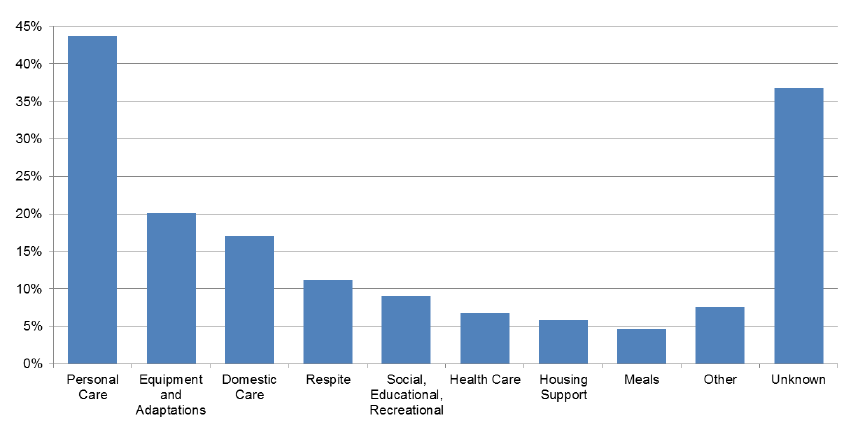
Information refers to the 22 local authorities with full SDS option recording (see Section 2.2).
Figure 4 shows the breakdown of clients by what mechanisms of support were provided. Note that clients can be identified as having more than one support mechanism and so the sum of percentages will exceed 100%. It shows that the largest support mechanism is the 'Local Authority' (55%) - that is, the local authority is who the client purchases services from, or has the service provided by. This option is generally expected to be selected for care packages involving an SDS Option 3 component. Over a third of clients (37%), however, were classed as having an 'Unknown' support mechanism, suggesting that there are additional recording issues to those identified in Section 2.2.
Figure 4: breakdown of support mechanism, 2014-15
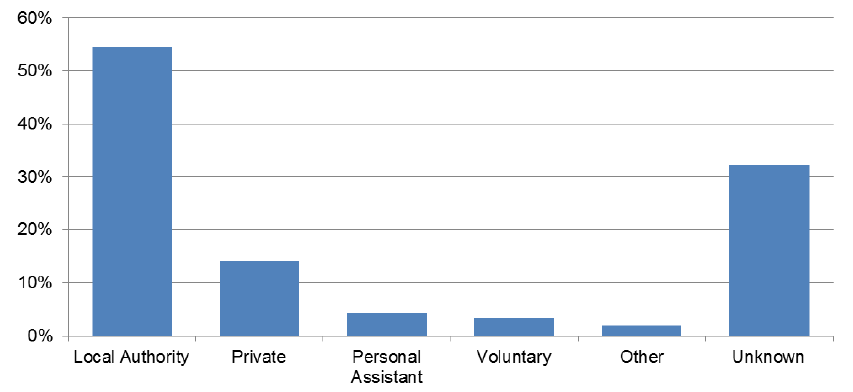
Information refers to the 22 local authorities with full SDS option recording (see Section 2.2).
3.2 Age Breakdown by Local Authority
Of the social care clients who made a choice regarding their services and support in 2014-15, 2% were aged under-18, 33% were aged 18-64 and 66% were aged 65+. This age distribution is a younger one compared with the Social Care Survey as a whole, where 75% of clients were aged 65+.
The estimated SDS implementation rate for social care clients aged 65+ is 17%, for those aged 18-64 it is 29% and for clients aged under-18 it is 30%. Implementation, therefore, has been more rapid for younger social care clients than for older clients.
Figure 5 shows the age breakdown of clients by local authority. It shows that Glasgow City, North Lanarkshire and East Lothian have the youngest age distributions, whilst Perth & Kinross has the oldest age breakdown.
Figure 5: breakdown of age by local authority, 2014-15
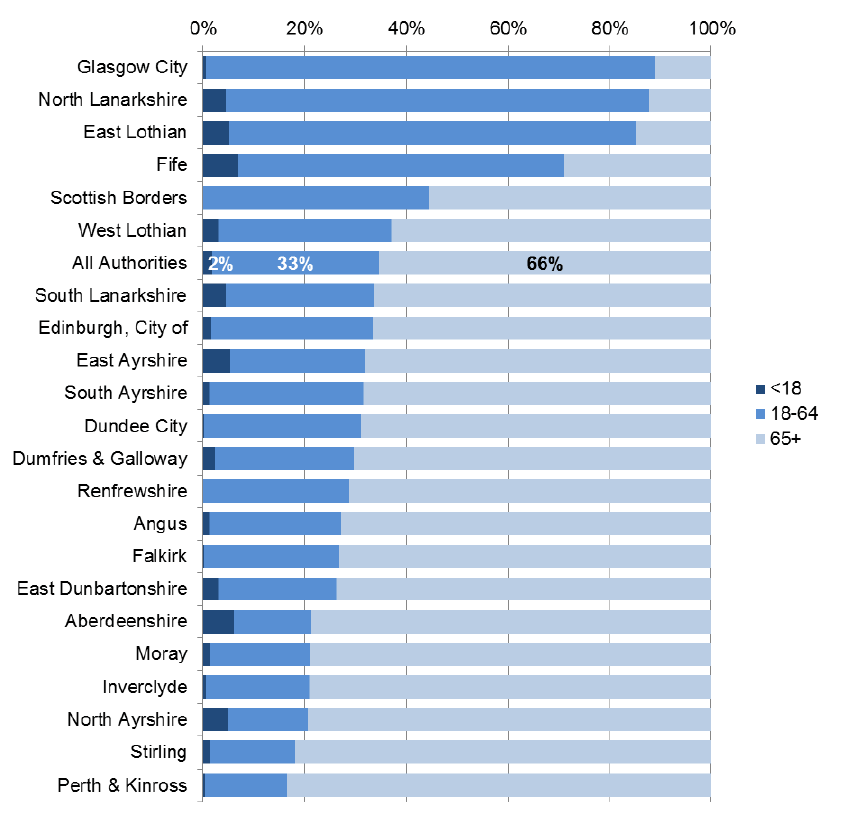
Information refers to the 22 local authorities with full SDS option recording (see Section 2.2).
3.3 Age and SDS Option Breakdown
Of the social care clients who made a choice regarding their services and support in 2014-15, 13% chose SDS Option 1, 9% chose Option 2, 75% chose Option 3 and 3% chose Option 4. The majority of clients, therefore, opted to retain council arranged services (Option 3) when assessed under SDS. It is important to note that, in addition to the data recording issues highlighted in Section 2.2, there is known to be some recording variation that will affect the distribution of Option 2 and Option 3 client figures.
Figure 6 shows that the breakdown of SDS options chosen varies according to client age group. Older people (aged 65+), who constitute the majority of social care clients, are much more likely to choose council arranged services (Option 3). Younger adults (aged under 18-64) are relatively more likely to choose a Direct Payment (Option 1) or an Individual Service Fund (Option 2) compared with older people, though Option 1 remained the most common choice. Young people (aged under-18), who only account for a small proportion of the total, are more likely to choose a Direct Payment (Option 1).
Figure 6: breakdown of SDS option choices by age of client, 2014-15
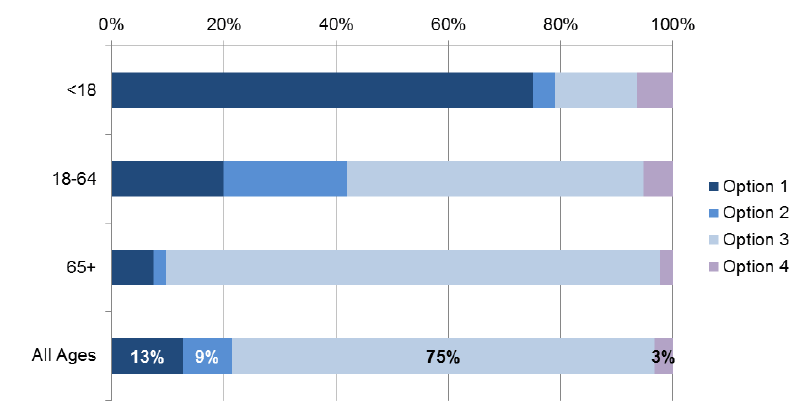
Information refers to the 22 local authorities with full SDS option recording (see Section 2.2) .
3.4 SDS Option Breakdown by Local Authority
Figure 7 (over page) shows that the breakdown of SDS options chosen varies across local authorities. This suggests that variations in implementation or data recording may play a significant role in the breakdown of options chosen. In 18 out of 22 of the local authorities considered here, Option 3 was the most popular choice. In Fife and Scottish Borders in contrast, Option 1 was the most popular choice [7] . Scottish Borders, furthermore, had the highest proportion of Option 4 clients out of the local authorities considered.
In Glasgow City and North Lanarkshire, Option 2 was the most popular choice. Together, Glasgow City and North Lanarkshire clients accounted for 85% of all recorded Option 2 clients of the local authorities considered here. In addition, Glasgow City and North Lanarkshire are the two local authorities with the youngest age distribution (see Section 3.2), which corresponds to the observation that younger clients are more likely to choose Option 1 and Option 2 (see Section 3.3).
Figure 7: breakdown of SDS option choices by local authority, 2014-15
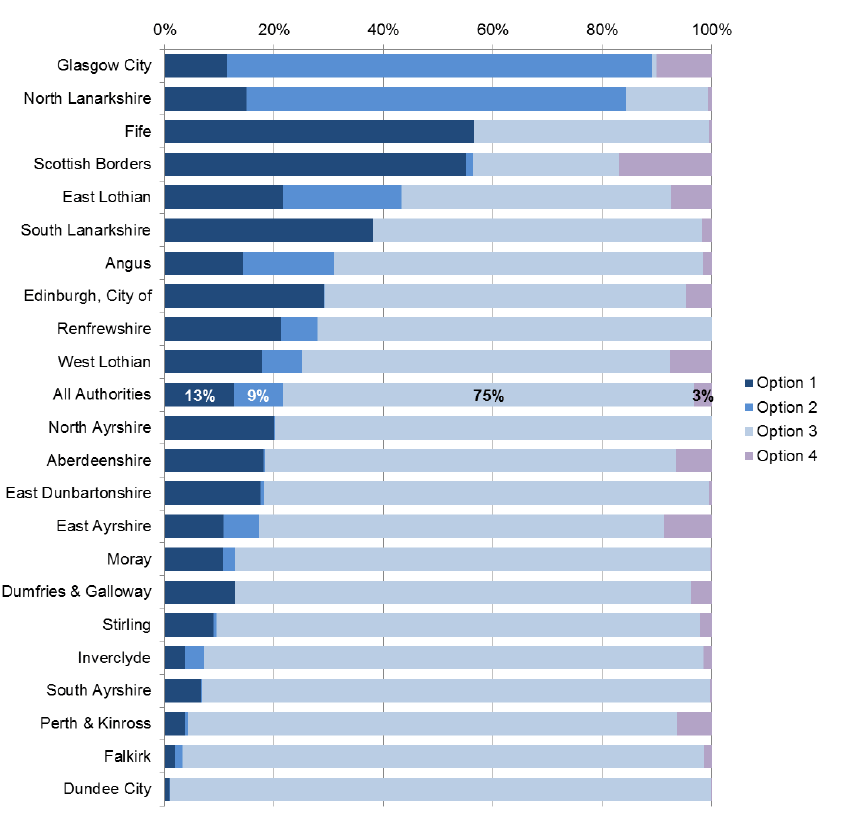
Information refers to the 22 local authorities with full SDS option recording (see Section 2.2) .
3.5 Gender Breakdown
Of the social care clients who made a choice regarding their services and support in 2014-15, 41% were male and 59% were female. This gender breakdown compares with 32% male and 68% female from the Social Care Survey as a whole. This gender split is broadly similar across the local authorities considered here, however in Glasgow City and North Lanarkshire the majority of clients were male (55% and 58% respectively). East Lothian also stood out as having a higher proportion of male clients (49%) compared to the average.
Figure 8 compares the gender breakdown for clients aged under 65 and those aged 65+. It shows that clients aged under 65 are more likely to be male whilst clients aged 65+ are more likely to be female. Women live longer than men on average, and thus the observed correlation of age and gender is not surprising. Glasgow City, North Lanarkshire and East Lothian have the youngest age breakdowns (see Section 3.2) of the local authorities, which corresponds to their gender breakdowns described above.
Figure 8: comparison of gender breakdown by age, 2014-15
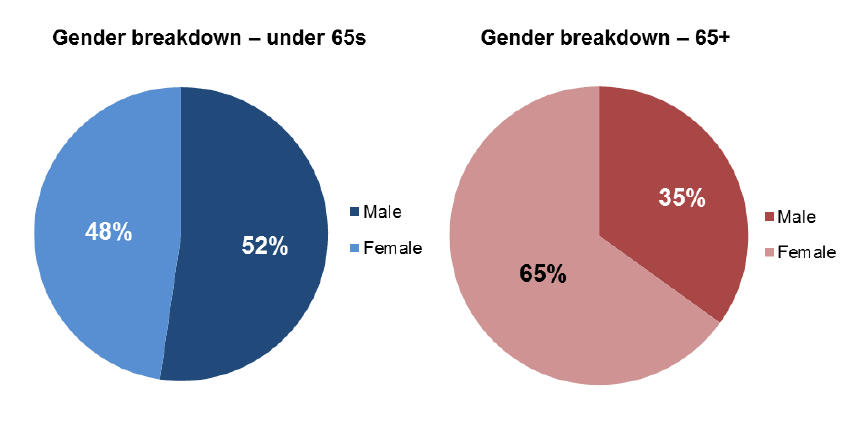
Information refers to the 22 local authorities with full SDS option recording (see Section 2.2) .
Contact
There is a problem
Thanks for your feedback